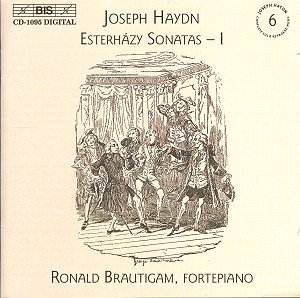Ronald Brautigam continues his series of Haydn keyboard
sonatas with this excellent offering, which includes three of the so-called
‘Esterházy Sonatas’ (Nos. 36-41 were published in a volume entitled
‘Six Sonatas for Prince Esterházy’ in February 1774).
No. 35 in A flat is of dubious authorship, splitting
historical musicologists in this regard. It was published in 1783 in
London by Beardmore and Birchall. It is notable for its absence of slow
movement: a brief Menuetto and Trio (in which Brautigam makes the most
of colouring the various registral shifts) separates a characterful
Allegro and a playful, pointed Rondo finale.
All of the Esterházy Sonatas include substantial
slow movements that considerably broaden the available emotional spectrum.
It is to these that Brautigam seems most attracted to: his playing is
always suave and involving. Playing on a brightly coloured McNulty copy
of a late eighteenth century Walter instrument (the tone of which is
excellently captured by BIS’s Ingo Petry), he responds to the harmonic
twists and turns in a way which renders the music consistently fascinating
(and Haydn’s Sonatas really can appear dull in the wrong hands). Similarly,
the predominantly two-part textures of the first movement of No. 36
never lose their way.
Brautigam’s way with the opening Allegro moderato of
Sonata No. 37 is almost orchestral in his confident presentation of
material. Small but telling tempo fluctuations make all the difference
to the ebb and flow of the argument. The more interior Andante which
follows provides further evidence of Brautigam’s sensitivity. Of the
three Esterházy Sonatas on the disc, this is the only one which
ends with a ‘Tempo di Menuet’: here it is the very essence of civility,
a successful alternative to a jaunty final scamper around the keyboard.
The Sonata No. 38 is the one piece on this disc which
overlaps with Joanna Leach’s latest offering on the Athene label (ATHCD22).
Leach plays on a Stodart square piano of 1823, and students of pianos
of this period may wish to acquire it for this reason: but in terms
of sheer musicianship, Brautigam is simply in another league. In particular,
the flowing, improvisatory feel he lends the Adagio places him, emotionally,
on a totally different level, but overall he seems to capture the essence
of Haydn in a way she cannot. His witty playing, not for the first time
on this disc, brought to mind the playing of Alfred Brendel, whose championing
of Haydn’s solo keyboard output (on the modern piano) has itself brought
much joy. Brautigam takes the finale at a true Presto, emphasising the
joyous nature of the piece and bringing a sense of joie de vivre
Leach cannot hope to attain. His articulation and rhythmic sense are
beyond reproach.
Brautigam is a player whose thoughtful and scholarly
approach (based on the Wiener Urtext edition) includes an awareness
of the many sides of Haydn’s expressive world. This disc will bring
repeated pleasure.
Colin Clarke



